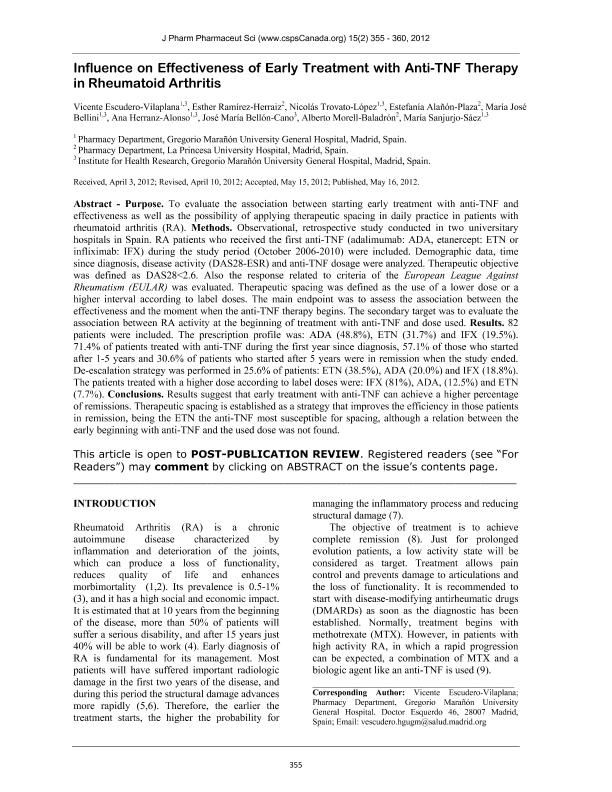Artículo
Influence on effectiveness of early treatment with anti-TNF therapy in rheumatoid arthritis
Escudero-Vilaplana, Vicente; Ramírez-Herraiz, Esther; Trovato-López, Nicolás; Alañón-Plaza, Estefania; Bellini, Maria Jose ; Herranz-Alonso, Ana; Bellón-Cano, José María; Morell-Baladrón, Alberto; Sanjurjo-Sáez, María
; Herranz-Alonso, Ana; Bellón-Cano, José María; Morell-Baladrón, Alberto; Sanjurjo-Sáez, María
 ; Herranz-Alonso, Ana; Bellón-Cano, José María; Morell-Baladrón, Alberto; Sanjurjo-Sáez, María
; Herranz-Alonso, Ana; Bellón-Cano, José María; Morell-Baladrón, Alberto; Sanjurjo-Sáez, María
Fecha de publicación:
16/05/2012
Editorial:
Canadian Society for Pharmaceutical Sciences
Revista:
Journal of Pharmacy and Pharmaceutical Sciences
ISSN:
1482-1826
Idioma:
Inglés
Tipo de recurso:
Artículo publicado
Clasificación temática:
Resumen
Purpose. To evaluate the association between starting early treatment with anti-TNF and effectiveness as well as the possibility of applying therapeutic spacing in daily practice in patients with rheumatoid arthritis (RA). Methods. Observational, retrospective study conducted in two universitary hospitals in Spain. RA patients who received the first anti-TNF (adalimumab: ADA, etanercept: ETN or infliximab: IFX) during the study period (October 2006-2010) were included. Demographic data, time since diagnosis, disease activity (DAS28-ESR) and anti-TNF dosage were analyzed. Therapeutic objective was defined as DAS28<2.6. Also the response related to criteria of the European League Against Rheumatism (EULAR) was evaluated. Therapeutic spacing was defined as the use of a lower dose or a higher interval according to label doses. The main endpoint was to assess the association between the effectiveness and the moment when the anti-TNF therapy begins. The secondary target was to evaluate the association between RA activity at the beginning of treatment with anti-TNF and dose used. Results. 82 patients were included. The prescription profile was: ADA (48.8%), ETN (31.7%) and IFX (19.5%). 71.4% of patients treated with anti-TNF during the first year since diagnosis, 57.1% of those who started after 1-5 years and 30.6% of patients who started after 5 years were in remission when the study ended. De-escalation strategy was performed in 25.6% of patients: ETN (38.5%), ADA (20.0%) and IFX (18.8%). The patients treated with a higher dose according to label doses were: IFX (81%), ADA, (12.5%) and ETN (7.7%). Conclusions. Results suggest that early treatment with anti-TNF can achieve a higher percentage of remissions. Therapeutic spacing is established as a strategy that improves the efficiency in those patients in remission, being the ETN the anti-TNF most susceptible for spacing, although a relation between the early beginning with anti-TNF and the used dose was not found.
Palabras clave:
Rheumatoid Arthritis
,
Anti-Tnf
Archivos asociados
Licencia
Identificadores
Colecciones
Articulos(INIBIOLP)
Articulos de INST.DE INVEST.BIOQUIMICAS DE LA PLATA
Articulos de INST.DE INVEST.BIOQUIMICAS DE LA PLATA
Citación
Escudero-Vilaplana, Vicente; Ramírez-Herraiz, Esther; Trovato-López, Nicolás; Alañón-Plaza, Estefania; Bellini, Maria Jose; et al.; Influence on effectiveness of early treatment with anti-TNF therapy in rheumatoid arthritis; Canadian Society for Pharmaceutical Sciences; Journal of Pharmacy and Pharmaceutical Sciences; 15; 3; 16-5-2012; 355-360
Compartir
Altmétricas



